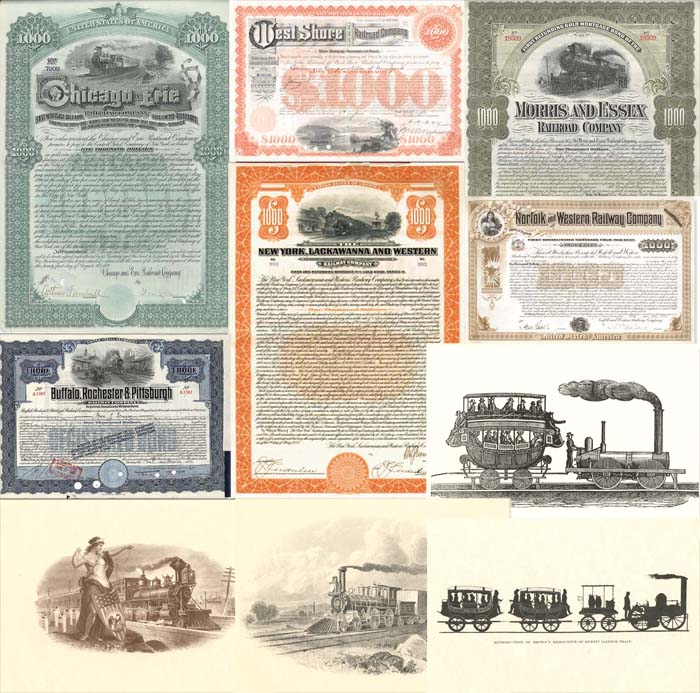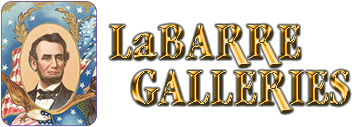Collection of 6 Railroad Bonds dating from 1890's-1950's & Prints - Chicago Erie, West Shore, Morris Essex, Buffalo Rochester Pittsburgh, New York Lackawanna Western & Norfolk Western
Inv# WW1101 Bond
New Jersey
New York
Pennsylvania
Virginia
Collection of 6 Railroad Bonds dating from 1890's-1950's and 4 Railroad Prints.
The Chicago and Atlantic Railway, later known as the Chicago and Erie Railroad, was a significant railway in the United States that operated from 1871 to 1941, connecting the Columbus, Ohio metropolitan area with Chicago, Illinois. It was originally established as the Chicago, Continental and Baltimore Railway in 1871 and was renamed the Chicago and Atlantic Railway in 1873. The railway's western terminus was in Hammond, Indiana, a suburb of Chicago, while the eastern terminus was in Marion, Ohio.
The railway faced financial difficulties, exacerbated by a tragic collision in 1887 near Kouts, Indiana, which resulted in the deaths of 10 people. These challenges led to several internal reorganizations and name changes. In 1890, the company went bankrupt and was restructured as the Chicago and Erie Railroad, with John G. McCullough serving as president. In 1895, the Erie Railroad acquired the Chicago and Erie Railroad, but the latter retained its name and identity until its consolidation in 1941.
The West Shore Railroad was the final name of a railroad that ran from Weehawken, New Jersey, on the west bank of the Hudson River across from New York City, extending north to Albany, New York, and then west to Buffalo. Initially organized to compete with the New York Central and Hudson River Railroad, it was soon acquired by that company.
The railroad's origins trace back to the Saratoga and Hudson River Railroad, which was incorporated on April 16, 1864, and began operations in the spring of 1866. After about a year of independent operation, the line was incorporated into the New York Central Railroad (NYC) system. It split at Athens Junction near Schenectady and ran southeast and south along the west side of the Hudson River to Athens, New York.
Early plans included extending the line north to acquire the Saratoga and Schenectady Railroad. On September 9, 1867, the Saratoga and Hudson River Railroad was purchased and merged into the New York Central Railroad, becoming its Athens Branch.
The Morris and Essex Railroad was a railroad that traversed northern New Jersey and later became part of the main line of the Delaware, Lackawanna and Western Railroad. It was incorporated on January 29, 1835, with the goal of constructing a line from Newark in Essex County westward to and beyond Morristown in Morris County.
The first section of the line, extending from Newark to Orange, opened on November 19, 1836. An agreement signed on October 21 with the New Jersey Rail Road facilitated a connection from Newark east to Jersey City via the Bergen Hill Cut. Initially, the connection between the two railroads was in downtown Newark, where the M&E line turned south on Broad Street to intersect with a branch of the NJRR at Market Street.
Service to Paulus Hook, now part of Jersey City, began on October 14, 1836. Passengers could transfer to the Jersey City Ferry to cross to lower Manhattan at nearby ferry slips. On January 1, 1838, the M&E extended its route to Morristown. Later, on October 29, 1838, an agreement moved the NJRR connection to the foot of Centre Street (via the northeast side of Park Place, aligning with the NJRR’s route along the Passaic River), leading to the removal of tracks on Broad Street. Through car service started on August 1, 1843, with horse power used along the streets between the Broad Street station and the foot of Centre Street.
The Buffalo, Rochester and Pittsburgh Railway (reporting mark BR&P) was one of the many railroad companies established in North America, and it outlasted most of them, serving communities from the shore of Lake Ontario to western Pennsylvania. By the mid-19th century, American industry had developed methods to utilize and economically transport bituminous coal from the mines in western Pennsylvania to where it was needed. This process initially relied on steam power for both railroad locomotives and factories.
The growing demand for coal necessitated a railroad to transport it from Pennsylvania’s coalfields to the cities of Rochester and Buffalo, as well as to smaller towns and villages along the way. The Buffalo, Rochester and Pittsburgh Railway emerged to fill the gap left by the Rochester and State Line Railroad and the Rochester and Pittsburgh Railroad, focusing on the coal-hauling market between these coalfields and the cities of Buffalo and Rochester. The mines produced vast amounts of steam coal needed by the Northeast’s factories and railroads.
However, the coal-transportation market attracted fierce competition. The era’s laissez-faire environment fostered practices such as creating paper railroads, buying and selling corporations like commodities, and financial manipulation by investor syndicates, complicating the reality of the industry.
The New York, Lackawanna and Western Railroad was chartered on August 26, 1880, and officially opened on September 17, 1882, as an extension of the Delaware, Lackawanna and Western Railroad (DL&W) from Binghamton westward and northwest to Buffalo, New York. The main line extended to the International Bridge connecting to Ontario, with a branch line serving downtown Buffalo. A spur from Wayland connected to Hornellsville (now Hornell).
On December 1, 1903, the DL&W began operating the Erie and Central New York Railroad, which extended from Cortland Junction east to Cincinnatus, as a branch of its Oswego line. That same year, the DL&W also took control of the Bangor and Portland Railway, which by 1909 was fully under its control. This line branched from the main line at Portland, Pennsylvania, and ran southwest to Nazareth, with an additional branch to Martins Creek.
The Norfolk and Western Railway (reporting mark NW), commonly known as the N&W, was a Class I railroad in the United States, formed through more than 200 mergers between 1838 and 1982. Headquartered in Roanoke, Virginia for most of its existence, the N&W operated under the motto "Precision Transportation" and was often nicknamed "King Coal" and the "British Railway of America."
The N&W was renowned for manufacturing its own steam locomotives and hopper cars at its Roanoke Shops. Notably, it was the last major Class I railroad to use steam locomotives, with the final Y class 2-8-8-2s retired between 1964 and 1965. In December 1959, N&W merged with its longtime rival, the Virginian Railway (reporting mark VGN), in the Pocahontas coal region.
By 1970, additional mergers with the Nickel Plate Road and Wabash Railroad created an extensive network spanning 7,595 miles (12,223 km) of road and 14,881 miles (23,949 km) of track, reaching from North Carolina to New York and Virginia to Iowa.
A bond is a document of title for a loan. Bonds are issued, not only by businesses, but also by national, state or city governments, or other public bodies, or sometimes by individuals. Bonds are a loan to the company or other body. They are normally repayable within a stated period of time. Bonds earn interest at a fixed rate, which must usually be paid by the undertaking regardless of its financial results. A bondholder is a creditor of the undertaking.










Ebay ID: labarre_galleries